 |
|
Orlando Sanford International Airport |
| Orlando-Sanford International Airport |
| IATA: SFB – ICAO: KSFB – FAA LID: SFB
Location of the Orlando Sanford International Airport
|
| Summary |
| Airport type |
Public |
| Owner |
Sanford Airport Authority |
| Serves |
Orlando, Florida |
| Location |
Sanford, Florida |
| Elevation AMSL |
55 ft / 17 m |
| Coordinates |
28°46′40″N 081°14′15″W / 28.77778°N 81.2375°W / 28.77778; -81.2375 |
| Website |
orlandosanfordairport.com |
| Runways |
| Direction |
Length |
Surface |
| ft |
m |
| 9C/27C |
3,578 |
1,091 |
Asphalt |
| 9L/27R |
9,600 |
2,926 |
Asphalt |
| 9R/27L |
6,647 |
2,026 |
Asphalt |
| 18/36 |
6,002 |
1,829 |
Asphalt/Concrete |
| Statistics (2007) |
| Aircraft operations |
320,884 |
| Based aircraft |
309 |
| Source: Federal Aviation Administration |
Orlando-Sanford International Airport (IATA: SFB, ICAO: KSFB, FAA LID: SFB) is a public commercial air service airport in Sanford, Florida, near Orlando. It was originally constructed as a military installation known as Naval Air Station Sanford that was in operation as a Master Jet Base for carrier-based attack and reconnaissance aircraft until 1969.
Due to heavy flight training operations at the airport, it is consistently in the top 30 busiest airports in the world in terms of total flight operations (takeoff and landings). It functions as the Orlando area's secondary commercial airport, but is located farther away from downtown Orlando and the attraction areas of Walt Disney World, Universal Studios Florida and SeaWorld Orlando than the larger, primary airport, Orlando International Airport (MCO/KMCO).
The airport is owned by the Sanford Airport Authority and managed by TBI plc, one of the world's leading airport operators, which owns London Luton Airport, Cardiff Airport, and Belfast International Airport in the United Kingdom, as well as Stockholm-Skavsta Airport in Sweden, and operates airports in South America. Because of that affiliation, Orlando Sanford International Airport is served primarily by British carriers. TBI is also the provider of ground handling services for airlines. Although it is primarily a landing point for European travel, Sanford is also the second largest focus city for Las Vegas-based Allegiant Air and the smallest focus city for Myrtle Beach-based Direct Air. HistoryNaval Air Station Sanford
Orlando-Sanford International Airport started life as Naval Air Station Sanford with the airport codes NRJ and KNRJ. Commissioned on November 3, 1942, the base initially concentrated on advanced land-based patrol plane trainng, operating PV-1 Venturas, PBO Hudsons and SNB-2 Kansans. Peak wartime complement reached approximately 360 officers and 1400 enlisted men with 150 officer and enlisted WAVES (Women Accepted for Volunteer Emergency Service) during 1943-1945. In 1944, training at NAS Sanford shifted to carrier-based fighter aircraft using the F4F and FM-1 Wildcat and F6F Hellcat. The air station also held oversight of an auxiliary airfield known as Outlying Field Osceola (OLF Osceola) approximately 6 nautical miles southeast of NAS Sanford.
Decommissioned in 1946 and placed in a caretaker status, the base was recommissioned as Naval Auxiliary Air Station Sanford (NAAS Sanford) in 1950 in response to both the Korean War and the Cold War. Subsequently redesignated as a full naval air station and renamed NAS Sanford, substantial upgrades followed in order to turn the air station into a Master Jet Base for the carrier-based Douglas A-3 Skywarrior (at the time, designated A3D) nuclear attack aircraft of Heavy Attack Wing ONE (HATWING ONE). In addition to the Skywarrior, other associated land-based training aircraft supporting A3D training, such as the P2V-3W Neptune, were also assigned.
The upgrades to the former NAAS to achieve status as a full-fledged NAS and Master Jet Base included lengthening of the main runway to 8000 feet with overruns of approximately 2000 additional feet on both ends, construction of additional new hangars, barracks and administrative support buildings for the air station, heavy attack wing and heavy attack squadrons, precision approach radar/ground controlled approach (PAR/GCA), non-directional beacon (NDB) and tactical air navigation (TACAN) navigational aids, a robust storage and distribution system for JP-5 jet fuel (which relied on resupply via a railroad spur into the base), a Navy Dispensary, Navy Exchange complex, base theater, two swimming pools, recreational facilities and separate clubs for officers, chief petty officers and enlisted personnel. Like Pinecastle AFB (later renamed McCoy AFB), a Strategic Air Command installation approximately 25 miles to the south, a commissary and full-fledged Naval Hospital facilities were not considered necessary at NAS Sanford due to the relatively close proximity of a commissary and USAF Hospital at Central Florida's other major military installation at the time, the nearby Orlando AFB (which was transferred to the U.S. Navy control in 1968 and renamed Naval Training Center Orlando).
NAAS / NAS Sanford also retained control of OLF Osceola into the early 1960s. However, OLF Osceola's 4000 to 5000 foot runways lacked sufficient length and pavement strength for contemporary carrier-based jet aircraft like the A3D. As a result, no improvements were made to the OLF's infrastructure.
HATWING ONE consisted of nine Heavy Attack Squadrons (VAH), also known as HATRONs: VAH-1, VAH-3, VAH-5, VAH-6, VAH-7, VAH-9, VAH-11, VAH-12 and VAH-13. All were Fleet deployable units with the exception of VAH-3, which conducted Replacement Air Group (RAG) functions. In addition to the HATWING ONE squadrons, Air Development Squadron FIVE (VX-5), based at NAWS China Lake, California also maintained a detachment at NAS Sanford.
Due to the Skywarrior's nuclear strike mission and the presence of an associated special weapons storage area at NAS Sanford, Marine Corps personnel provided both base security and special weapons storage area security, leading to the establishment of Marine Corps Barracks Sanford.
On February 6, 1959, NAS Sanford was dedicated as Ramey Field in honor of Lieutenant Commander Robert W. Ramey, USN, who lost his life by electing to guide his crippled A3D Skywarrior away from a residential area. By staying with the aircraft, LCDR Ramey not only gave his flight crew time to bail out of the aircraft, but also saved the lives of numerous families in the residential community.
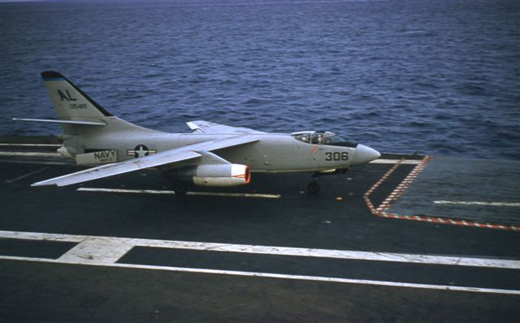 | |
An A3D-1 Skywarrior of Heavy Attack Squadron THREE (VAH-3). VAH-3 was the Replacement Air Group (RAG) squadron for the Atlantic Fleet A3D/A-3 community at NAS Sanford. |
In the early 1960s, the A-3 aircraft began to be replaced by the Mach 2+ North American A-5A Vigilante aircraft. But by 1964, the strategic nuclear strike mission for carrier-based aircraft was eliminated and the Navy's nuclear strike mission under the SIOP was transferred to the Fleet Ballistic Missile (FBM) nuclear submarine force. As a result, all Vigilante squadrons were converted to a carrier-based tactical reconnaissance mission and redesignated as Reconnaissance Attack Squadrons (RVAH). Existing A-5A and A-5B aircraft were modified to the RA-5C Vigilante configuration and the North American production line shifted to producing all subsequent aircraft as RA-5Cs. Heavy Attack Wing ONE was renamed Reconnaissance Attack Wing ONE and NAS Sanford-based squadrons routinely deployed aboard both Atlantic and Pacific Fleet aircraft carriers of the FORRESTAL, KITTY HAWK and ENTERPRISE classes, seeing extensive action during the Vietnam War. Numerous RA-5C flight crews and aircraft were lost to enemy action, with several Sanford-based Naval Aviators and Naval Flight Officers becoming prisoners of war in Vietnam until repatriation in 1973. In addition to RA-5C aircraft, NAS Sanford also continued to operate the TA-3B variant of the Skywarrior, several examples of which were attached to the RA-5C Fleet Replacement Squadron (FRS), Reconnaissance Attack Squadron THREE (RVAH-3) for training Naval Flight Officers as Reconnaissance Attack Navigators (RAN) in the RA-5C. NAS Sanford also operated the R4D-8/C-117 Skytrain as an operational support aircraft assigned to the air station proper.
Congress closed NAS Sanford in 1968 due to funding constraints caused by the Vietnam War, transferring the wing and squadrons to the former Turner AFB, renamed as NAS Albany, Georgia. The wing and squadrons subsequently relocated to NAS Key West, Florida during 1974-75 and continued to deploy to both the Atlantic, Mediterranean and Pacific aboard FORRESTAL, KITTY HAWK, ENTERPRISE and NIMITZ class aircraft carriers. RA-5C units remained operational at NAS Key West until the RA-5C's retirement from active service in 1980. A commemorative NAS Sanford Memorial Park, along with plaques and a retired RA-5C Vigilante aircraft on loan from the National Museum of Naval Aviation were dedicated in May 2003 and are positioned on the main entrance road within the Orlando Sanford International Airport perimeter in memory to NAS Sanford personnel who served their country during World War II, Vietnam and the Cold War. A
PV-1 Ventura, also on loan from the National Museum of Naval Aviation, is in the process of being restored at the airport and will join the RA-5C on display. An A-3 Skywarrior has also been requested from the Navy for future restoration and display.
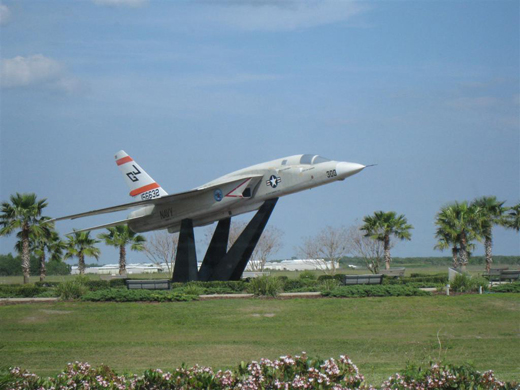 | |
RA-5C Vigilante, BuNo 156632, in the markings of Reconnaissance Attack Squadron THREE (RVAH-3) on display at Orlando Sanford International Airport (former NAS Sanford) in late March 2008 |
Sanford Regional Airport / Central Florida Regional Airport / Orlando Sanford Regional Airport /
Orlando Sanford International Airport
The City of Sanford assumed control of the former NAS Sanford in 1969 and renamed the facility Sanford Airport, hiring the air station's recently retired Executive Officer, Commander J. S. "Red" Cleveland, USN (Ret.), as the first Airport Manager. The city concurrently established the Sanford Airport Authority as its policy and oversight body. For the next twenty-five years, the airport was a general aviation facility, supporting numerous locally-based and transient private and corporate aircraft and periodically hosting combined civilian/military air shows and associated static displays. Initially functioning as an uncontrolled airfield, the former Navy control tower was reactivated in the early 1970s as a non-FAA facility, employing a number of retired enlisted Navy air traffic controllers who had previously served at NAS Sanford.
Additional name changes followed, to include Sanford Regional Airport, Central Florida Regional Airport, Orlando Sanford Regional Airport and the current Orlando Sanford International Airport. Throughout the 1980s and 1990s, many of the former Navy buildings that had been constructed during World War II had reached the end of their useful service life and were demolished, while those constructed by the Navy in the 1950s and 1960s were renovated and improved for civilian use. Additional construction of new buildings and hangars also took place.
OLF Osceola was transferred to the control of Seminole County, Florida but was never officially recommissioned as an active airfield. In the 1970s, the former OLF began to be used by general aviation drug smuggling aircraft as a transshipment point. Following a major drug interdiction by local and federal law enforcement agencies, Seminole County placed large "speed bumps at various intervals across the runway to deter future illegal use. By the 1980s, the county began to utilize the site as a landfill and dump, demolishing remaining runway infrastructure.
In 1992, major portions of the action film Passenger 57, starring Wesley Snipes, were filmed at the then-Orlando Sanford Regional Airport, where it represented a small airport in Louisiana. Shortly after filming, a new control tower was constructed and air traffic control operations assumed by the FAA. The former Navy control tower and the large former Navy hangar to which it had been attached were then demolished.
In the mid-1990s, a new passenger terminal capable of accommodating commercial jet airline service, was constructed and charter airlines catering to the heavy British tourist demographic that had previously been utilizing Orlando International Airport were offered greatly reduced landing fees if they would use Orlando Sanford International Airport and many of these carriers subsequently relocated their operations. Scheduled international and domestic air service soon followed, as reflected by current operations by Icelandair and Allegiant Air.
The airport is also home to Delta Connection Academy, a subsidiary of Delta Air Lines, which provides ab initio flight training for prospective regional airline pilots. The Seminole County Sheriff's Office also maintains a hangar and support facility at the airport for aviation elements of the agency's Special Operations Division.
Facilities
Orlando Sanford International Airport covers 2,010 acres (813 ha) and has four runways:
- Runway 9L/27R: 9,600 x 150 ft. (2,926 x 46 m), Surface: Asphalt
- Runway 9C/27C: 3,578 x 75 ft. (1,091 x 23 m), Surface: Asphalt
- Runway 9R/27L: 6,647 x 75 ft. (2,026 x 23 m), Surface: Asphalt
- Runway 18/36: 6,002 x 150 ft. (1,829 x 46 m), Surface: Asphalt/Concrete
The dominant runway is 9L/27R. This was constructed from the naval air station's original Runway 9/27, which was an 8,000 x 200 ft landing area with overruns of 2,145 ft and 1,985 ft, respectively. Parallel Runways 9C/27C and 9R/27L were later constructed, the former on a previous taxiway and the latter as new construction, to support light general aviation aircraft. The airport also has available Runway 18/36, another Navy-constructed runway, for rare northerly fronts that occur in the winter, although at 6,002 feet in length, this runway is not used for normal commercial traffic.
Allegiant Air also announced it would be moving many of its flights to larger, and more centrally located, Orlando International Airport.
Airlines and destinations
| Airlines |
Destinations |
Terminal |
| Allegiant Air |
Appleton/Green Bay, Bangor, Cedar Rapids, Chattanooga, Duluth, Elmira/Corning, Fargo, Fort Wayne, Greensboro, McAllen, Northwest Arkansas, Owensboro/Daviess County (KY), Plattsburgh (NY), Roanoke, Rockford/Chicago, Shreveport, Sioux Falls, South Bend, Toledo, Wilmington (NC) |
B |
| Direct Air operated by Xtra Airways |
Kalamazoo, Worcester |
B |
| Iceland Express |
Reykjavik-Keflavík |
B |
| Icelandair |
Reykjavik-Keflavík [seasonal] |
B |
| Monarch Airlines |
London-Gatwick, Manchester (UK) |
A |
| Thomas Cook Airlines |
Glasgow-International [seasonal], London-Gatwick [seasonal], Manchester (UK) [seasonal] |
A |
| Thomson Airways |
Birmingham (UK) [seasonal], Bristol [seasonal], East Midlands [seasonal], Glasgow-International [seasonal], London-Gatwick, Manchester (UK), Newcastle upon Tyne [seasonal] |
A |
Incidents and accidents
- In October 1961, A3D-2 (A-3B) Bureau Number (BuNo) 142663, assigned to Heavy Attack Squadron FIVE (VAH-5), crashed near NAS Sanford following a mid-air collision with another A3D-2 (A-3B) assigned to Heavy Attack Squadron ELEVEN (VAH-11). All four crewmen in the VAH-5 aircraft were killed.
- In January 1962, A3D-2 (A-3B) BuNo 142243, assigned to Heavy Attack Squadron ELEVEN (VAH-11), crashed near NAS Sanford following an in-flight emergency. All crewmen bailed out safely.
- On November 27, 1962, A-5A BuNo 148927 was stricken at NAS Sanford following a ground mishap. No flight crew were aboard during the mishap.
- On September 5, 1963, A-5A BuNo 148930, assigned to Heavy Attack Squadron THREE (VAH-3), crashed at NAS Sanford. Both crewmen ejected.
- On September 3, 1964, RA-5C BuNo 151616, assigned to Reconnaissance Attack Squadron ONE (RVAH-1), crashed at NAS Sanford. Both crewmen ejected.
- On September 8, 1964, RA-5C BuNo 149292, assigned to Reconnaissance Attack Squadron THREE (RVAH-3), crashed at NAS Sanford. Both crewmen ejected.
- On November 14, 1964, RA-5C BuNo 149308, assigned to Reconnaissance Attack Squadron NINE (RVAH-9), crashed at NAS Sanford. Both crewmen ejected.
- On December 23, 1964, RA-5C BuNo 151821, assigned to Reconnaissance Attack Squadron THIRTEEN (RVAH-13), crashed at NAS Sanford. Both crewmen ejected.
- On December 15, 1965, RA-5C BuNo 150827, assigned to Reconnaissance Attack Squadron THREE (RVAH-3), crashed at NAS Sanford. Both crewmen ejected.
- On June 14, 1967, RA-5C BuNo 149314, assigned to Reconnaissance Attack Squadron THREE (RVAH-3), crashed at NAS Sanford during Field Carrier Landing Practice. During a touch-and-go landing, aircraft sustained in-flight ingestion of a loose clamp into the starboard engine with subsequent foreign object damage (FOD) and fire. Both crewmen ejected. The pilot, LCDR Butler, was killed; the Naval Flight Officer/Reconnaissance Attack Navigator (NFO/RAN), ENS Smith, survived.
- On October 3, 1967, RA-5C BuNo 149315, assigned to Reconnaissance Attack Squadron THREE (RVAH-3), crashed at NAS Sanford. The pilot ejected; there was no NFO/RAN aboard.
- On March 29, 2007, Allegiant Air Flight 758, a McDonnell Douglas MD-80 aircraft which took off from Pease International Airport in Portsmouth, New Hampshire, experienced a hydraulic failure which prevented the nose landing gear from deploying. The plane made a safe landing at Orlando Sanford, with only one minor injury sustained in the aircraft evacuation.
- On July 10, 2007, On Tuesday July 10, 2007, a Cessna 310, originating from Daytona Beach International Airport, Florida en route to Lakeland Linder Regional Airport crashed into two homes in Sanford, Florida, near Orlando, killing five people—the pilot, his passenger, and three people inside the houses. The pilot reported smoke in the cockpit and attempted an emergency landing at nearby Orlando Sanford International Airport. NASCAR said the pilot of the plane was Michael Klemm, a senior captain with NASCAR Aviation. His passenger was Dr. Bruce Kennedy, husband of International Speedway Corporation president Lesa France Kennedy, the daughter of the longtime head of NASCAR, Bill France, Jr., who had died a month earlier in June, 2007. They were the only two people on the plane, according to both NASCAR and the NTSB. Four people also were injured, three of whom were critically burned, authorities said.
The NTSB factual report dated December 2007 indicates that the accident was caused by an electrical malfunction, including smoke in the cockpit, that occurred on the previous flight and that was not rectified prior to the accident flight, resulting in the subsequent fire. The accident pilot was informed about the known problem prior to flight, but elected to fly the aircraft regardless.
The above content comes from Wikipedia and is published under free licenses – click here to read more.
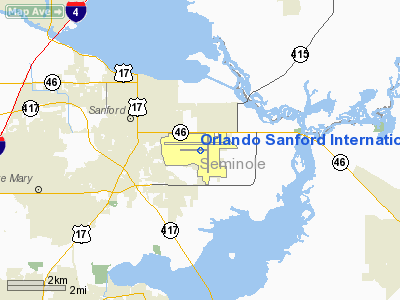
|
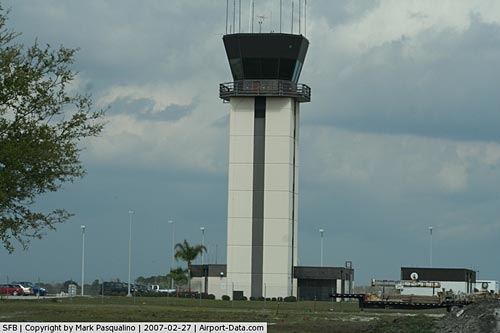 |
(Click on the photo to enlarge) |
|
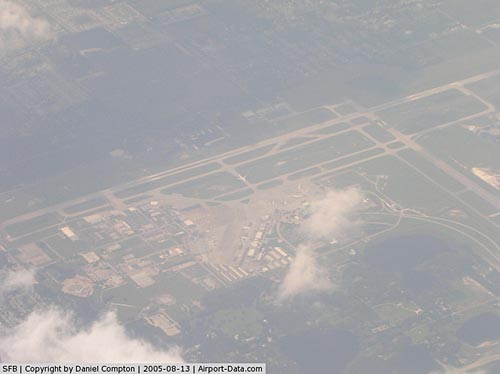 |
(Click on the photo to enlarge) |
|
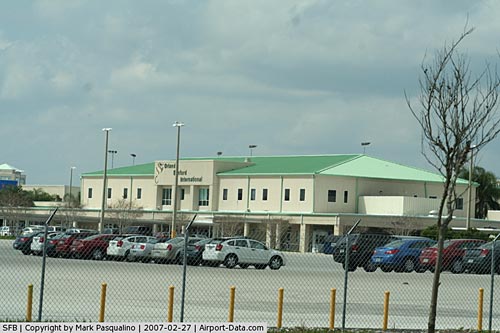 |
(Click on the photo to enlarge) |
|
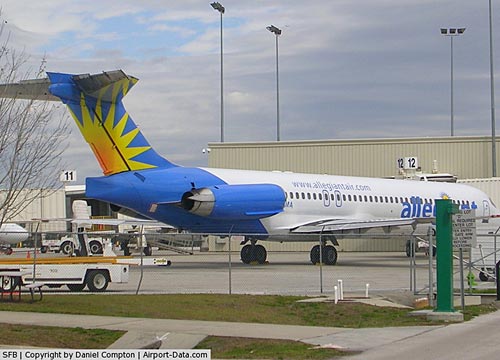 |
(Click on the photo to enlarge) |
|
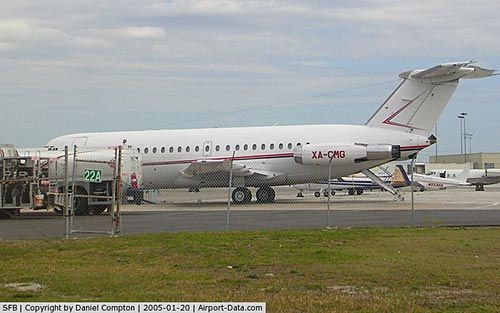 |
(Click on the photo to enlarge) |
Location
& QuickFacts
|
FAA Information Effective: |
2007-01-18 |
|
Airport
Identifier: |
SFB |
|
Airport
Status: |
Operational |
|
Longitude/Latitude: |
081-14-14.9620W/28-46-39.5040N
-81.237489/28.777640 (Estimated) |
|
Elevation: |
55 ft / 16.76 m (Surveyed) |
|
Land: |
2200 acres |
|
From
nearest city: |
16 nautical miles NE of Orlando, FL |
|
Location: |
Seminole County, FL |
|
Magnetic Variation: |
05W (2000) |
Owner
& Manager
|
Ownership: |
Publicly owned |
|
Owner: |
Sanford Arpt Authority |
|
Address: |
1200 Red Cleveland Blvd, Suite #200
Sanford, FL 32773-0818 |
|
Phone
number: |
407-585-4000 |
|
Manager: |
Larry A. Dale |
|
Address: |
1200 Red Cleveland Blvd
Sanford, FL 32772-0818 |
|
Phone number: |
407-585-4000 |
Airport
Operations and Facilities
|
Airport Use: |
Open to public |
|
Wind
indicator: |
Yes |
|
Segmented
Circle: |
Yes |
|
Control
Tower: |
Yes |
|
Lighting
Schedule: |
DUSK-DAWN
WHEN ATCT CLSD ACTVT HIRL RY 09L/27R, MIRL RY 18/36, PAPI
RYS 09L, 27R, 18, & 36 - CTAF. |
|
Beacon
Color: |
Clear-Green (lighted land airport) |
|
Landing
fee charge: |
No |
|
Sectional
chart: |
Jacksonville |
|
Region: |
ASO - Southern |
|
Traffic
Pattern Alt: |
1000 ft |
|
Boundary
ARTCC: |
ZJX - Jacksonville |
|
Tie-in
FSS: |
PIE - Saint Petersburg |
|
FSS
on Airport: |
No |
|
FSS
Toll Free: |
1-800-WX-BRIEF |
|
NOTAMs
Facility: |
SFB (NOTAM-d service avaliable) |
|
Certification
type/date: |
I D S 04/2005
CLSD TO REPETITIVE ACR TRAINING OPNS EXCP 24 HRS PPR CTC
AMGR 407-585-4000 EXT 4006 OR 407-585-4119. ARFF INDEX E
AVBL WITH 24 HR PPR (CHARTER CARRIERS ON PUBLISHED SKED
EXEMPT). |
|
Federal Agreements: |
NGPY |
Airport
Communications
Airport
Services
|
Fuel available: |
100LLA |
|
Airframe Repair: |
MAJOR |
|
Power Plant Repair: |
MAJOR |
|
Bottled
Oxygen: |
HIGH |
|
Bulk
Oxygen: |
NONE |
|
Runway Information
Runway 09C/27C
|
Dimension: |
3578 x 75 ft / 1090.6 x 22.9 m |
|
Surface: |
ASPH, Good Condition |
|
Weight
Limit: |
Single wheel: 12000 lbs. |
|
Edge
Lights: |
Medium
MIRL RY 18/36 ON CONTINUOUSLY MED INTNST AT NIGHT. |
|
|
Runway 09C |
Runway 27C |
|
Longitude: |
081-14-43.7023W |
081-14-03.4942W |
|
Latitude: |
28-46-42.4343N |
28-46-42.4907N |
|
Elevation: |
52.00 ft |
48.00 ft |
|
Alignment: |
90 |
127 |
|
Traffic
Pattern: |
Right |
Left |
|
Markings: |
Basic, Good Condition |
Basic, Good Condition |
|
Crossing
Height: |
35.00 ft |
27.00 ft |
|
VASI: |
2-light PAPI on left side |
2-light PAPI on left side |
|
Visual
Glide Angle: |
4.00� |
3.00� |
|
Runway
End Identifier: |
Yes |
|
|
Obstruction: |
75 ft pole, 2075.0 ft from runway, 25:1 slope
to clear |
62 ft trees, 2250.0 ft from runway, 100 ft
left of centerline, 33:1 slope to clear |
|
Runway 09L/27R
|
Dimension: |
9600 x 150 ft / 2926.1 x 45.7 m |
|
Surface: |
ASPH, Good Condition |
|
Surface
Treatment: |
Saw-cut or plastic Grooved |
|
Weight
Limit: |
Single wheel: 30000 lbs.
Dual wheel: 170000 lbs.
Dual
tandem wheel: 300000 lbs. |
|
Edge
Lights: |
High
MIRL RY 18/36 ON CONTINUOUSLY MED INTNST AT NIGHT. |
|
|
Runway 09L |
Runway 27R |
|
Longitude: |
081-15-21.4295W |
081-13-33.5481W |
|
Latitude: |
28-46-54.2453N |
28-46-54.4173N |
|
Elevation: |
52.00 ft |
31.00 ft |
|
Alignment: |
90 |
127 |
|
ILS
Type: |
ILS |
ILS/DME |
|
Traffic
Pattern: |
Left |
Right |
|
Markings: |
Precision instrument, Good Condition |
Precision instrument, Good Condition |
|
Crossing
Height: |
71.00 ft |
75.00 ft |
|
Displaced
threshold: |
1000.00 ft |
600.00 ft |
|
VASI: |
4-light PAPI on left side |
4-light PAPI on left side |
|
Visual
Glide Angle: |
3.00� |
3.00� |
|
Approach
lights: |
MALSR |
MALSR |
|
Obstruction: |
, 50:1 slope to clear |
36 ft trees, 2000.0 ft from runway, 20 ft right
of centerline, 50:1 slope to clear |
|
Decleard
distances: |
Take off run available 9600.00 ft
Take off distance available 9600.00 ft
Actual stop distance available 9600.00 ft
Landing distance available 8600.00 ft |
Take off run available 9600.00 ft
Take off distance available 9600.00 ft
Actual stop distance available 9600.00 ft
Landing distance available 9000.00 ft |
|
Runway 09R/27L
|
Dimension: |
3500 x 75 ft / 1066.8 x 22.9 m |
|
Surface: |
ASPH, Good Condition |
|
Weight
Limit: |
Single wheel: 12000 lbs. |
|
Edge
Lights: |
Medium
MIRL RY 18/36 ON CONTINUOUSLY MED INTNST AT NIGHT. |
|
|
Runway 09R |
Runway 27L |
|
Longitude: |
081-14-08.1087W |
081-13-28.7839W |
|
Latitude: |
28-46-11.7912N |
28-46-11.8480N |
|
Elevation: |
46.00 ft |
28.00 ft |
|
Alignment: |
90 |
127 |
|
Traffic
Pattern: |
Right |
Left |
|
Markings: |
Basic, Good Condition |
Basic, Good Condition |
|
Crossing
Height: |
45.00 ft |
45.00 ft |
|
VASI: |
4-light PAPI on right side |
4-light PAPI on left side |
|
Visual
Glide Angle: |
3.00� |
3.00� |
|
Runway
End Identifier: |
Yes |
Yes |
|
Obstruction: |
65 ft trees, 2000.0 ft from runway, 250 ft
right of centerline, 27:1 slope to clear |
, 50:1 slope to clear |
|
Runway 18/36
|
Dimension: |
6002 x 150 ft / 1829.4 x 45.7 m |
|
Surface: |
ASPH-CONC, Good Condition |
|
Surface
Treatment: |
Saw-cut or plastic Grooved |
|
Weight
Limit: |
Single wheel: 30000 lbs.
Dual wheel: 170000 lbs.
Dual
tandem wheel: 300000 lbs. |
|
Edge
Lights: |
Medium
MIRL RY 18/36 ON CONTINUOUSLY MED INTNST AT NIGHT. |
|
|
Runway 18 |
Runway 36 |
|
Longitude: |
081-14-05.2374W |
081-14-05.1022W |
|
Latitude: |
28-46-59.8264N |
28-46-00.4023N |
|
Elevation: |
48.00 ft |
43.00 ft |
|
Alignment: |
127 |
127 |
|
Traffic
Pattern: |
Left |
Right |
|
Markings: |
Basic, Good Condition |
Basic, Good Condition |
|
Crossing
Height: |
45.00 ft |
45.00 ft |
|
VASI: |
4-light PAPI on left side |
4-light PAPI on left side |
|
Visual
Glide Angle: |
3.00� |
3.00� |
|
Runway
End Identifier: |
Yes |
Yes |
|
Decleard
distances: |
Take off run available 6003.00 ft
Take off distance available 6003.00 ft
Actual stop distance available 5956.00 ft
Landing distance available 5956.00 ft |
Take off run available 6003.00 ft
Take off distance available 6003.00 ft
Actual stop distance available 6003.00 ft
Landing distance available 6003.00 ft |
|
Radio Navigation
Aids
|
ID |
Type |
Name |
Ch |
Freq |
Var |
Dist |
|
SFB |
NDB |
Sanford |
|
408.00 |
05W |
0.5 nm |
|
DED |
NDB |
Deland/dcmsnd |
|
201.00 |
05W |
17.5 nm |
|
EVB |
NDB |
New Smyrna Beach |
|
417.00 |
04W |
22.8 nm |
|
GGL |
NDB |
Geiger Lake |
|
375.00 |
05W |
24.8 nm |
|
LEE |
NDB |
Leesburg |
|
335.00 |
04W |
30.1 nm |
|
ISM |
NDB |
Kissimmee |
|
329.00 |
05W |
31.1 nm |
|
COI |
NDB |
Merritt Island |
|
247.00 |
05W |
39.1 nm |
|
SQT |
NDB |
Satellite |
|
257.00 |
03W |
49.7 nm |
|
TTS |
TACAN |
Kennedy Space Center |
059Y |
|
00E |
30.0 nm |
|
COF |
TACAN |
Patrick |
097X |
|
04W |
46.3 nm |
|
ORL |
VORTAC |
Orlando |
059X |
112.20 |
00E |
15.0 nm |
|
OMN |
VORTAC |
Ormond Beach |
073X |
112.60 |
00E |
32.3 nm |
|
DAB |
VOT |
Daytona Beach |
|
111.00 |
|
26.1 nm |
Remarks
- NOISE
SENSITIVE AREA UNDER ILS APCH FM SEMCO OUTER MARKER TO RY 09L &
FM 4 MILES OUT STRAIGH-IN TO RY 27R.
- TWY
K CLSD TO ACFT WITH WINGSPAN GREATER THAN 80 FT.
- PAEW
ON TRML RAMP WITHIN 75 FT OF TWY C CNTRLN WHEN ACFT USING GATES 3 OR
4.
- TWY
'P' CLSD TO ACFT WITH WINGSPAN GREATER THAN 40 FT.
- RYS
09C/27C AND 09R/27L NON-ACR USE ONLY.
- RYS
18/36 & 09L/27R PRIMARY RYS FOR ACR OPNS.
- 210
FT OF RY 18/36 1302 FT FM RY 18 THLD UNGROOVED.
- TURBOJETS
ARE TO USE COMPANY FLY QUITE OR PUBLISHED NOISE ABATEMENT PROCEDURES.
- DENSE
FLT TRAINING ACTIVITY IN TFC PAT & LCL AREA.
- LARGE
BIRDS; INCLUDING EAGLES INVOF ARPT.
- ALL
ACFT WITH LESS THAN 30 SEATS ARRIVING TO CLEAR CUSTOMS CTC 129.075 PRIOR
TO LANDING.
- RY
09R/27L PRIMARY FLT TRAINING RY.
Based Aircraft
|
Aircraft
based on field: |
367 |
|
Single
Engine Airplanes: |
249 |
|
Multi
Engine Airplanes: |
50 |
|
Jet Engine
Airplanes: |
62 |
|
Helicopters: |
6 |
Operational Statistics
Time Period: 2005-02-01
- 2006-01-31
|
Aircraft
Operations: |
868/Day |
|
Commerical: |
3.0% |
|
Air Taxi: |
0.4% |
|
General
Aviation Local: |
63.5% |
|
General
Aviation Itinerant: |
33.2% |
|
Military: |
0.0% |
Orlando Sanford International Airport
Address:
Seminole County, FL
Tel:
407-585-4000
Images
and information placed above are from
http://www.airport-data.com/airport/SFB/
We
thank them for the data!
| General
Info |
| Country |
United
States |
| State |
FLORIDA
|
| FAA ID |
SFB
|
| Latitude |
28-46-39.504N
|
| Longitude |
081-14-14.962W
|
| Elevation |
55 feet
|
| Near City |
ORLANDO
|
We don't guarantee the information is fresh and accurate. The data may
be wrong or outdated.
For more up-to-date information please refer to other sources.
|
 |









